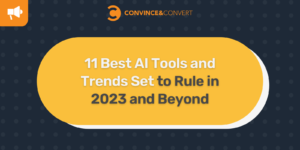Social media and search engine optimization (SEO) are part of the same marketing department. But ask either department how their team works together and you’ll be greeted with a confused face.
The lines between social media and SEO are blurred.
Are social shares a ranking factor? And if not, do search engines take the metrics that social media gives into consideration?
This guide shares the short (and long) answers.
[Tweet “How Social Media Can Help Boost Your Organic Rankings via @CoSchedule”]
Download Social Media SEO Templates
Before you move on to learn how social media can boost your organic search rankings, make sure you have the templates you’ll need to apply your knowledge immediately.
[content_upgrade_shortcode]
Table of Contents
- Are social shares a Google ranking factor?
- How social media impacts SEO
- How to use social media to improve SEO efforts
- Social signals are not used by Google yet… But it’s coming
Are Social Shares a Google Ranking Factor?
Matt Cutts, a spokesperson for Google, said its search engine rankings are not directly impacted by social media shares:
But just because social isn’t a defined ranking signal, that doesn’t mean that the social media vitality of a page has zero influence over where it ranks for a given keyword.
Known ranking factors—like direct website visits, bounce rate, and time on site—are metrics influenced by social media marketing. You can use platforms like Twitter, LinkedIn, and Facebook to drive people to your website. On-page optimization will get them to stick around and view more pages, giving search engines the signals they need to rank your URL higher.
How Social Media Impacts SEO
While social sharing isn’t a defined ranking factor in Google’s search algorithm, two-thirds of marketers believe there’s a correlation between social shares on a specific page and its overall search ranking.
Let’s break down how social media helps with an SEO strategy.
Potential to Acquire Backlinks
Social media networks have bigger audiences than most websites. Almost half (48%) of the world’s population is using some kind of social media website. That’s an audience of 3.78 billion.
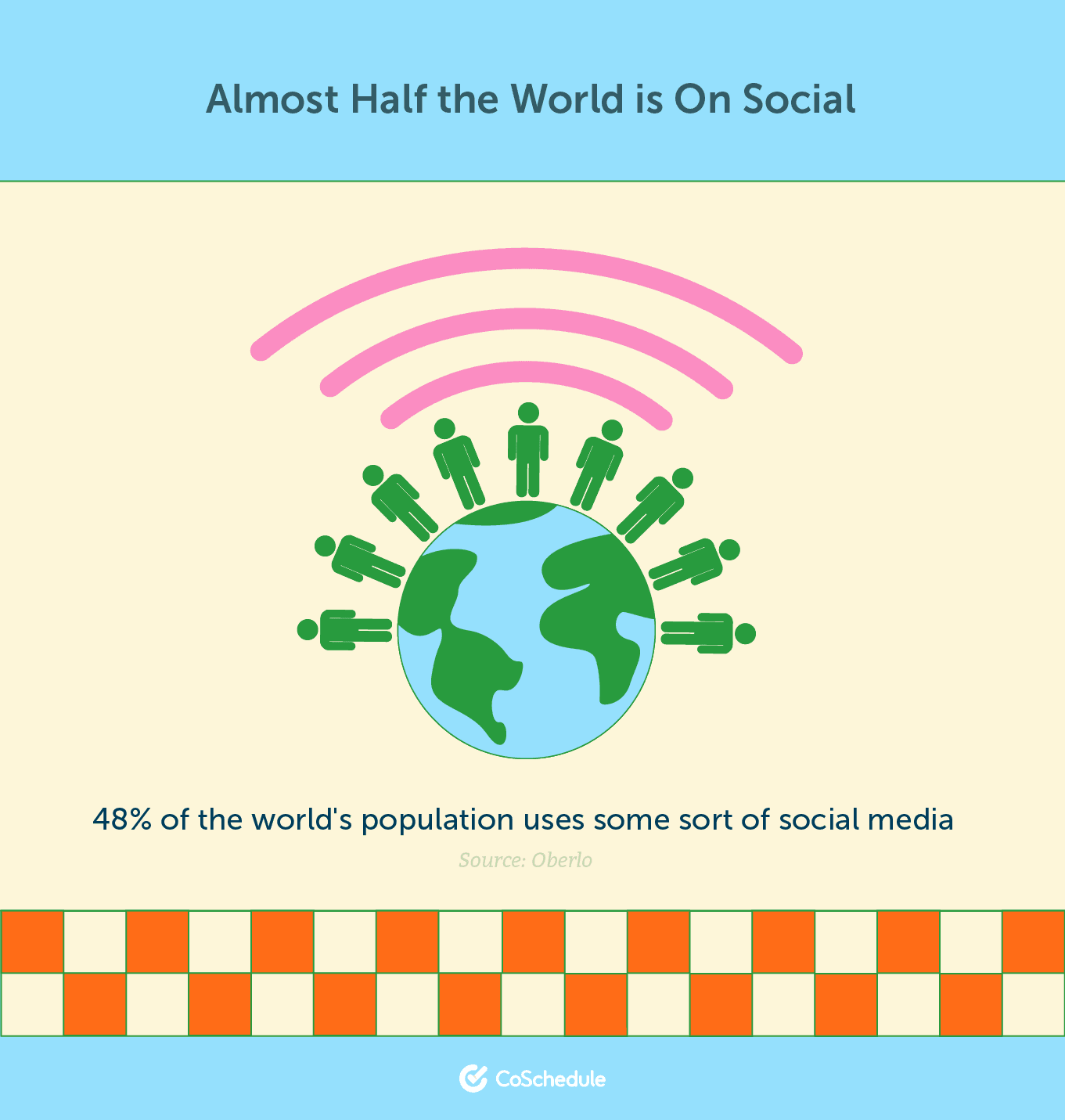
Other website publishers form part of that audience.
In fact, writers and marketers rely on social media to find new content ideas. Out of this comes a mutually beneficial relationship. SEOs share their website content on social media; writers looking for unique content to link to include it in their own content.
Not convinced? Let’s use CoSchedule’s guide on the best time to send an email as an example. It has 2.5K social media engagements across Facebook, Twitter, Reddit, and Pinterest:

While it’s not possible to say those social shares had the biggest impact on its SEO success, there’s no doubt it influenced the 1K+ backlinks it acquired from 700+ unique domains. (Even if it didn’t, it dramatically reduced how much time their team had to spend on manual link building.)
More people sharing the guide meant more eyeballs—and more chance of writers quoting the guide in their own content:
A combination of strong backlinks, on-page optimization, and social shares means the guide ranks for 1.5K keywords including “best time to send email”, driving almost 5K organic visitors per month.

Enhance Brand Reputation
Did you know that over 50% of brand reputation comes from online sociability?
Social media users rely on their favorite platforms to learn about brands, be educated, and entertained. That journey is where most brand reputations form.
Both Google’s algorithm and real humans take this reputation into consideration.
Let’s start with the first. Google’s algorithm is complex, but can be boiled down into one mission statement: to deliver the best, highest quality, most relevant result for any given term. Trusted sites—those with a good reputation—are more likely to make the cut than those without.
On the human user side, research found that companies risk losing 22% of business when potential customers find a negative article on a Google search engine results page (SERP).
A social media strategy can replace any negative coverage, swapping the bad press with a link to your profile—especially since the Domain Rating (DR) of social media sites is higher than most publications.
We can see this in action when Googling HelpScout. Instead of news coverage or reviews, the first four organic results are links to their website and social media profiles. There’s no immediate reason to be concerned about their reputation, nor distractions to read about their product on a third-party site:
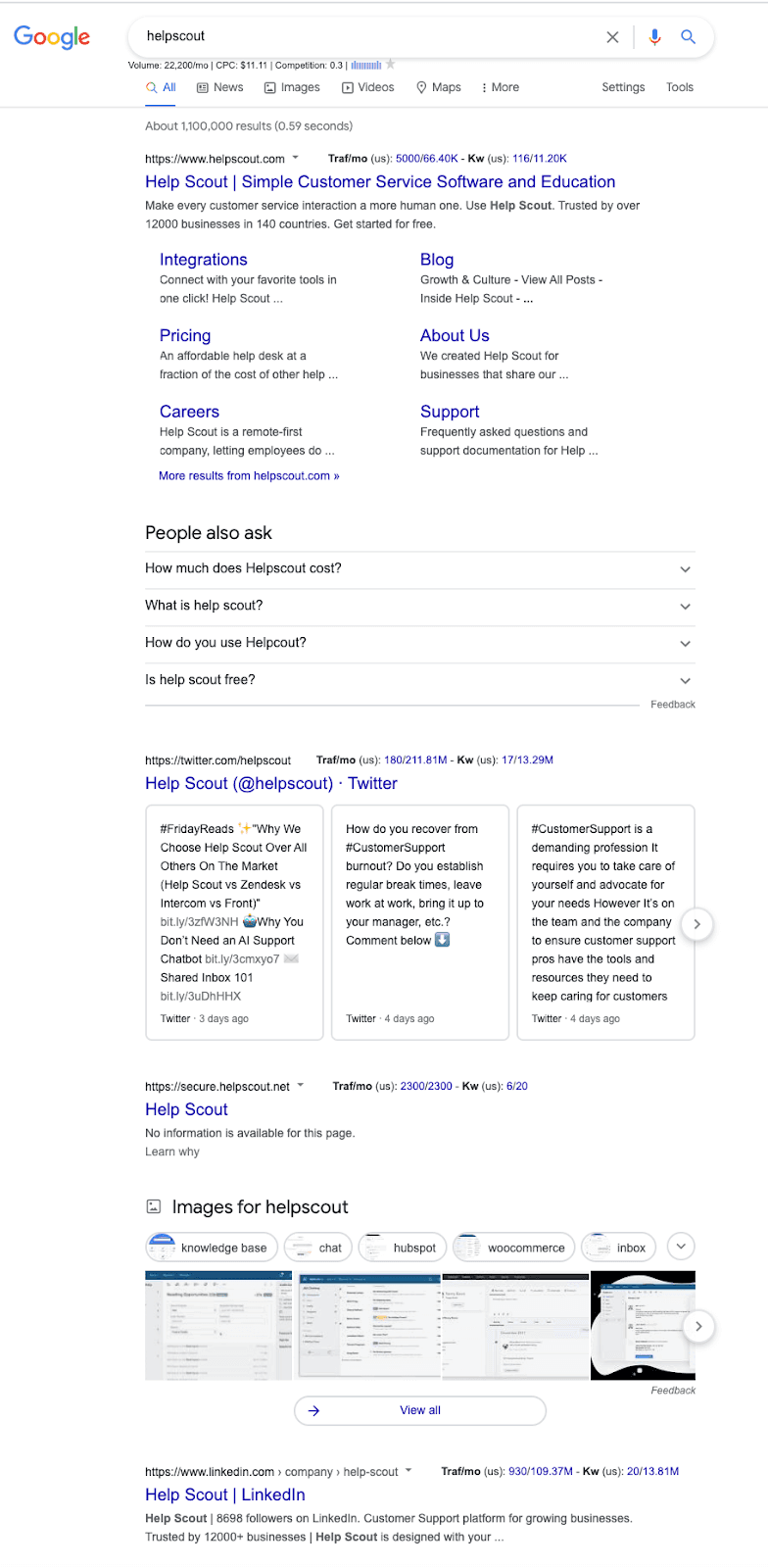
Increase Branded Search Traffic
It’s no secret that social media has the power to catapult the number of people who recognize your brand. But a captive social media audience that recognizes your content offers more benefits than an increased engagement rate.
Posting relevant content increases the likelihood of a follower buying your products or services when they need it. You’re top of mind.
When they are ready to buy, they have options. They could click the link in your social media bio. But if you’ve made a great impression and worked on building your reputation, users could also head to search engines to do a branded search.
This tweet shows that concept in action. Nextiva shares a video that explains why its target customers should use its cloud phone system:
Calling all small businesses: Looking to upgrade your business phone system to something more flexible and packed with features? Consider a cloud phone system!
Learn more: https://t.co/3mVK2nIQLM#smallbusinessmonth #smallbusinessweek #smb pic.twitter.com/nnFkwUQnop
— Nextiva (@Nextiva) May 6, 2021
The natural progression of the tweet is to watch the YouTube video. When the video convinces them to use Nextiva, there’s a strong chance the person will search Google with a branded search query like “cloud based phone system.”
Nextiva’s SEO team meets those searching Google with this keyword with a landing page optimized for that keyword:
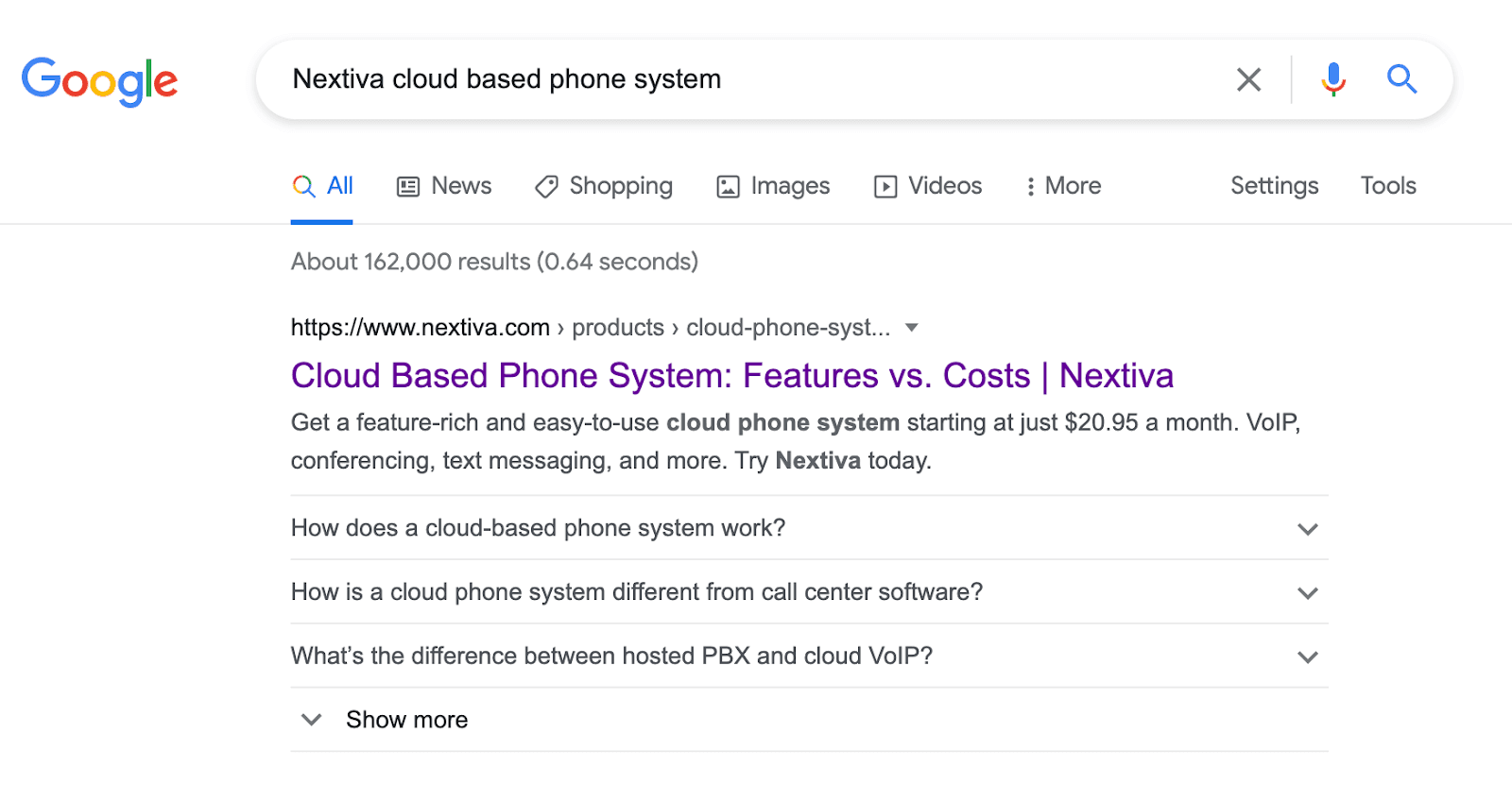
The power of branded search is huge. Most of the top 20 most-searched phrases on Google are branded—including “Facebook,” “Ebay,” and “Walmart.”
This branded search activity carries over to online shopping, too. Research shows that 82% of people who carried out a shopping-related research task on a search engine chose a brand they were already familiar with.
(It’s no surprise why there was a 136% year-over-year growth in branded search in 2019.)
Social Media Influencers Appeal to the E-A-T Algorithm
Google is always looking for ways to improve its search results (hence why they release several algorithm updates every year.)
One of the biggest changes to its algorithm was the introduction of E-A-T, which stands for:
- Expertise: How experienced or knowledgeable is the author on the subject matter?
- Authority: How credible is the website publishing the content?
- Trustworthiness: How much trust do people have in the publisher?
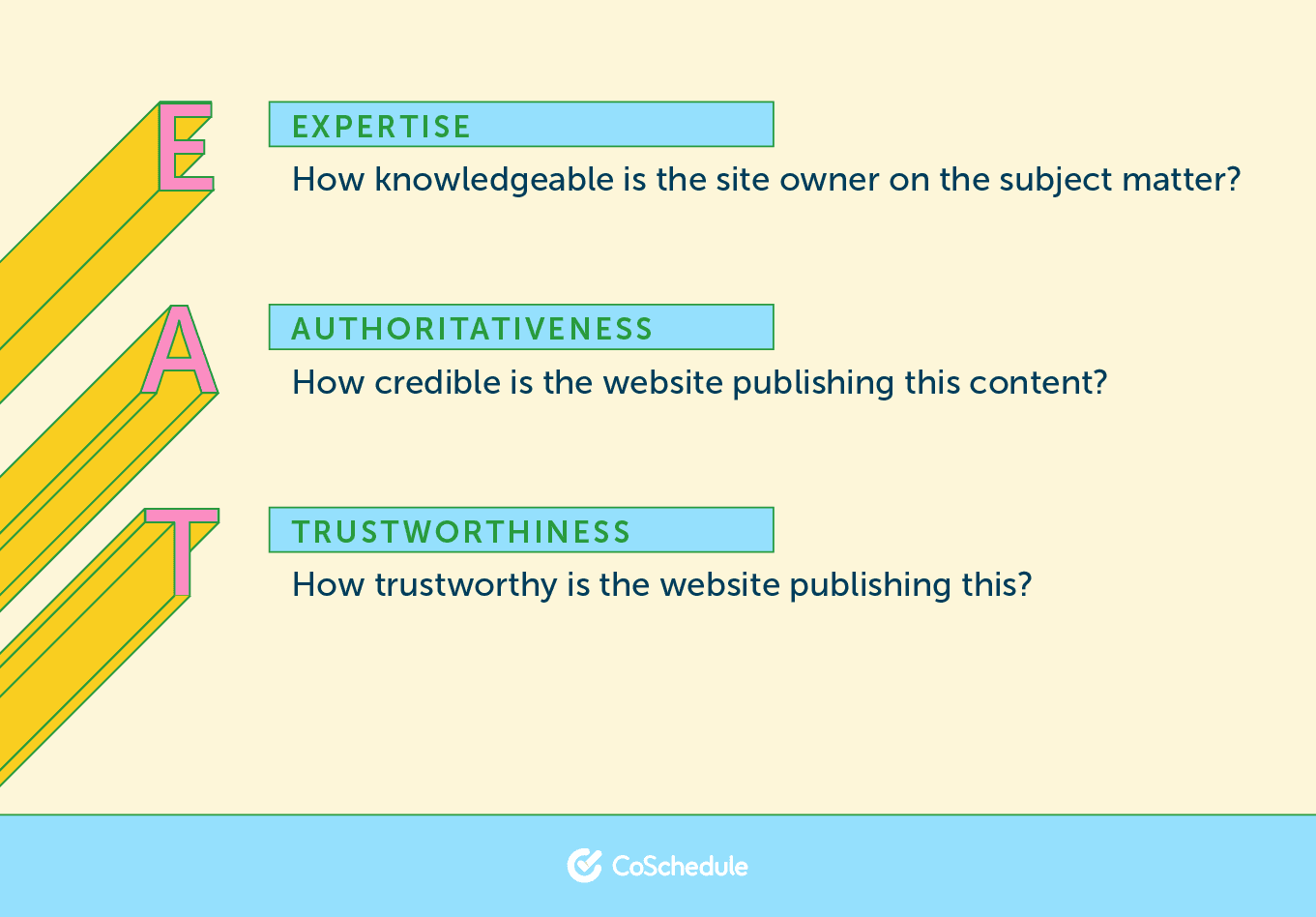
Working with influencers increases how likely you are to meet their E-A-T guidelines.
Let’s put that into practice and say you’re trying to rank for “SEO software”—a competitive term that your target audience is likely searching for.
On-site content from bloggers like Rand Fishkin or Shama Hyder—even if it’s an embedded social media post of them endorsing your product—would go a long way. It’d prove to Google that your site is best-positioned to help a user searching for “SEO software” because the page is connected to industry experts that Google (and your audience) already trusts.
One brand did this using social media analytics to find popular content it could compete with. They settled on “unhealthiest foods”—a competitive term searched by 1,300 people every month.
After using the insights and doing on-page SEO optimization, the post went viral on social media (more than 134K engagements to date). The content got shared by mega influencers in the food space.
Not long later, it climbed to position #2 and claimed the featured snippet for related long-tail keywords.
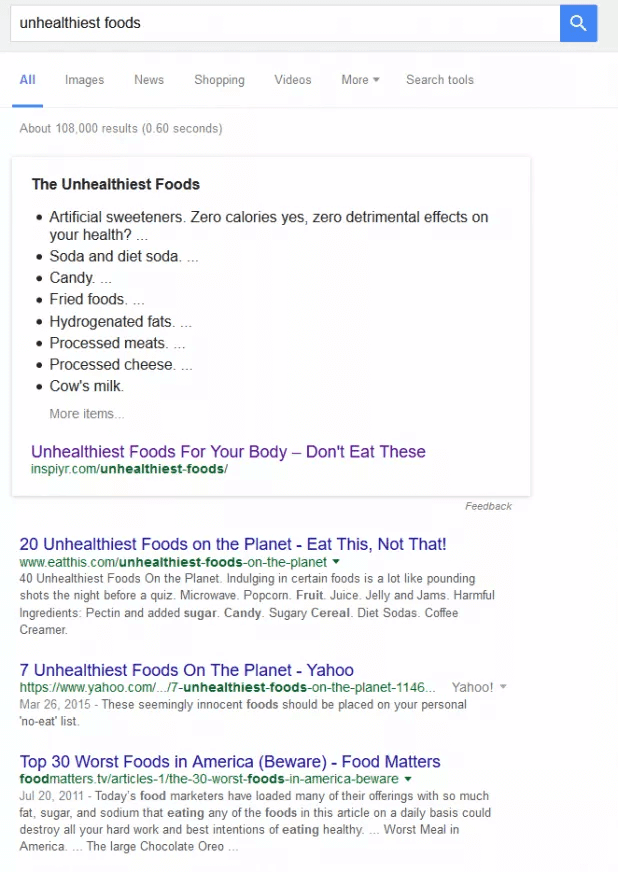
How to Use Social Media to Improve SEO Efforts
The entire “does social media impact SEO?” debate can be condensed into one equation:
More social visibility = more links = higher rankings.
Now we know the relationship between the two, let’s take a look at four practical ways you can tie in your social media activity with an SEO strategy.
1. Share New Posts on Social Media to Get Them Indexed Quicker
Search engines need to index your website before it appears in their list of results.
It takes up to one month for a page to be indexed. Social media can speed up this process.
Google finds new content by scanning its existing database. Platforms like Twitter, Facebook, and LinkedIn are already huge parts of their database—meaning that by sharing your content on social media immediately after it’s published, you can get new content indexed faster.
The good news is this entire process can be automated. Inside CoSchedule, you can connect your CMS (like WordPress) to your social media accounts. It’ll automatically share new content on social media whenever it gets published, helping Google (and your audience) find it faster.
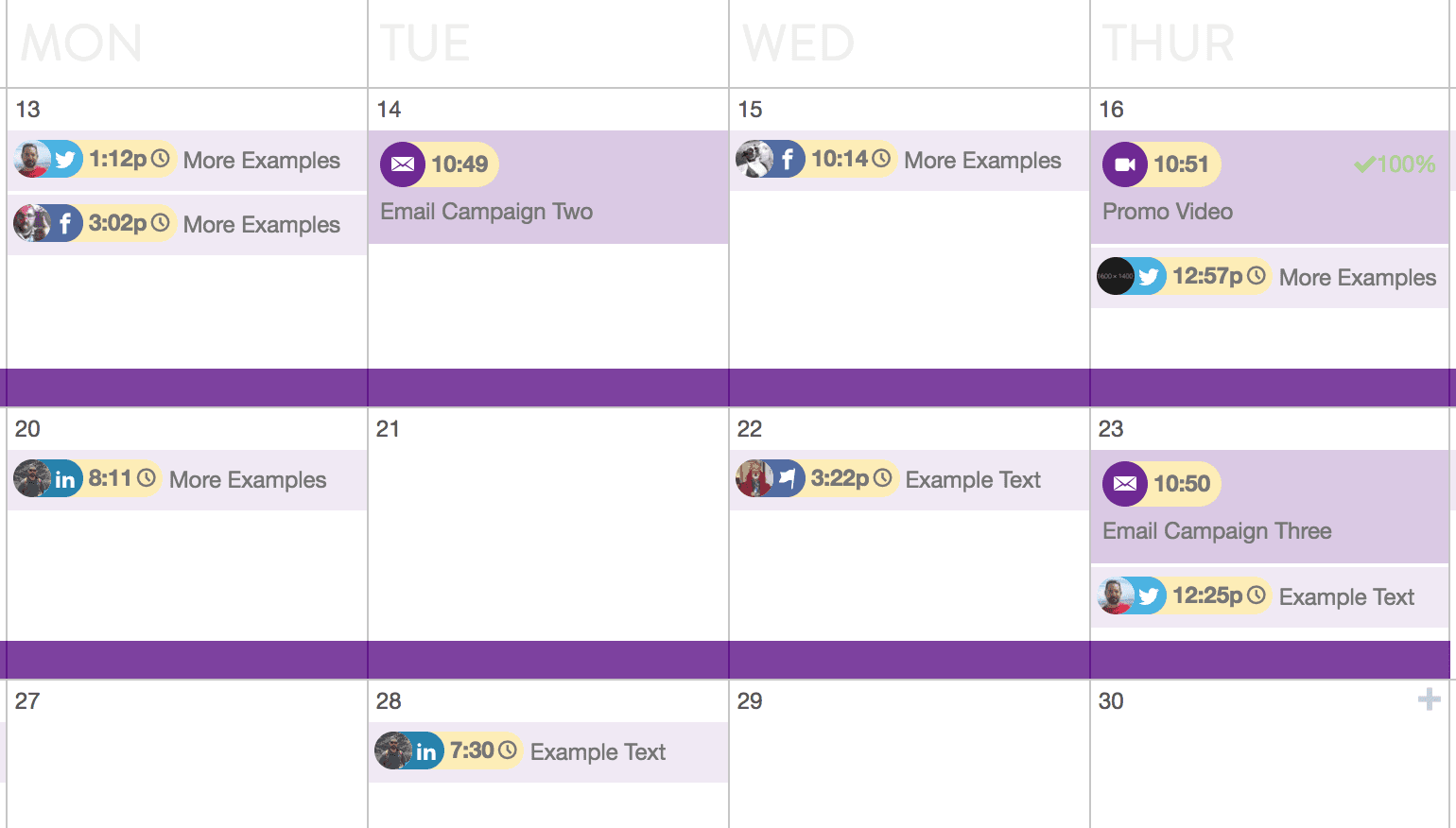
2. Use Social Media for Keyword Research
Keyword research is a huge part of any SEO strategy. It works by uncovering the terms your audience is searching for so your content, which is optimized for the same term, can meet them in the search engine. One of my all time favorite tactics to employ is to research low search volume keywords to find keywords which do not get a lot of searches but are a perfect fit to intercept your prospective customer.
Social media has a wealth of data on low search keywords you can use to determine which specific keywords you should be going after—particularly when it comes to hashtags.
Hashtags are one of the most popular ways for people to get their content found on platforms like Twitter and Instagram. For SEOs, they’re not just a way to attract more people; they’re short, memorable phrases that often have organic search volume, too.
SparkToro helps to uncover what your audience talks about online. Plug their suggestions into a keyword research tool like Ahrefs, and figure out whether there’s enough demand for you to create SEO content around it (which you’ll later share on social).

3. Use Social Media Data to Create High-Quality Content
Data is valuable for any digital marketing strategy—social media, SEO, and content marketing included.
Platforms like Buzzsumo show the most popular social media content in a given industry. You can use those insights to improve your content, get more shares, and rank higher.
Let’s put that into practice and say you’re writing about B2B customer service. Enter that term into Buzzsumo and you’ll see which type of content gets the most social shares. In this case, it’s behind-the-scenes looks at companies doing it well:
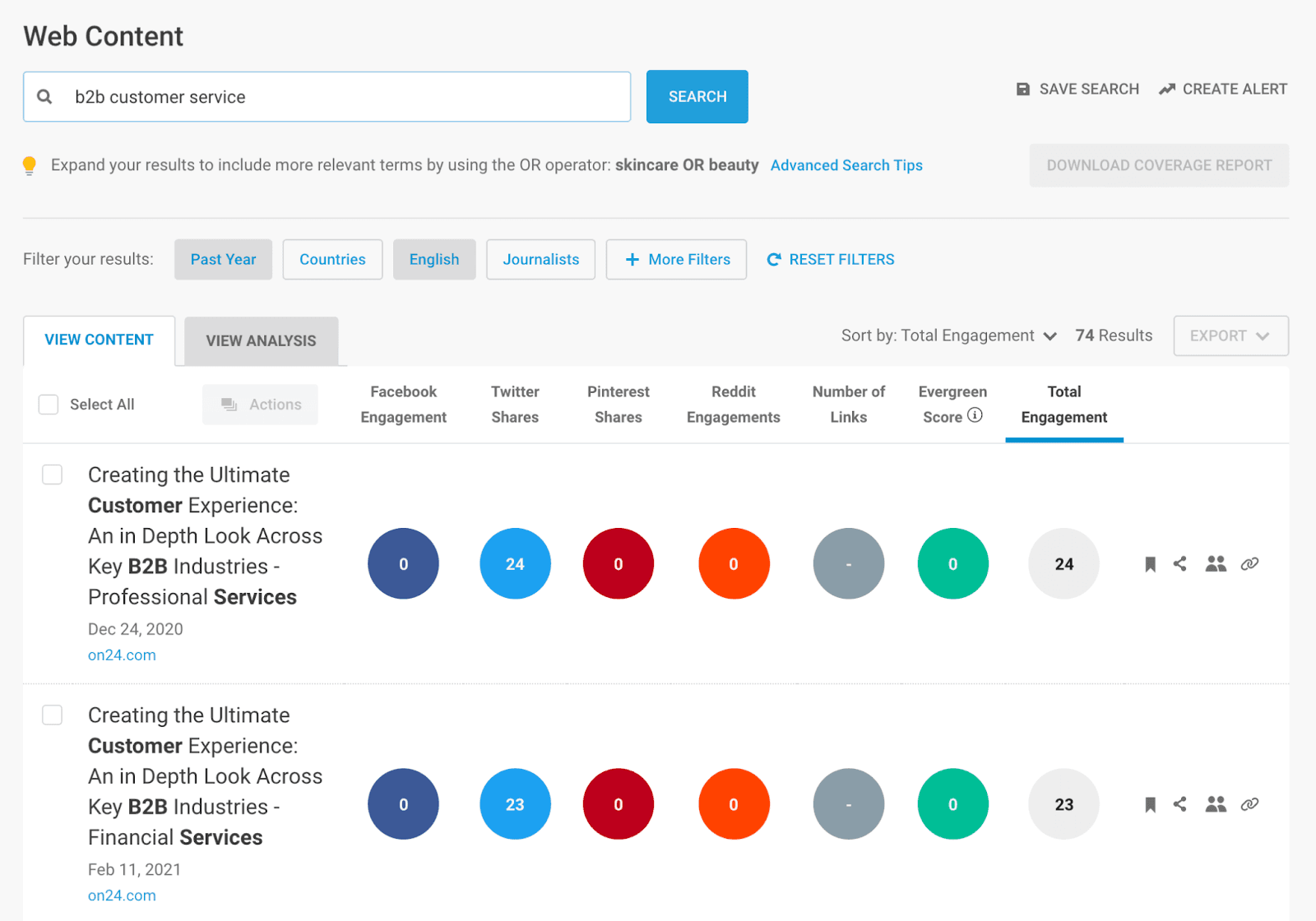
There are several ways you can use these insights to create valuable content for your SEO strategy:
- Reference the most popular examples/case studies
- Get unique quotes from the top journalists on the topic
- Embed the most popular social media posts in your content
- Replicate infographics that are popular on social media
Either way, you’re using social media insights to guide what people are most likely to share. Not only will it result in high-quality content that could get more social shares itself, but you’ll be rewarded by Google for creating engaging content.
4. Drive Traffic While You Wait to Rank
We’ve already touched on the fact it can take a while for Google to index a new piece of content. That doesn’t mean you have to sit around and wait for it to be found, though.
Content promotion is a piece of the digital marketing strategy that often gets neglected. Marketers spend hours creating new content… only to move onto the next piece as soon as it gets published.
Social media has the potential to drive traffic while you wait for Google to rank it.
This new post, for example, got 1,600+ views in its first week of being shared on LinkedIn… all before it had time to rank in the search results for its main keyword:
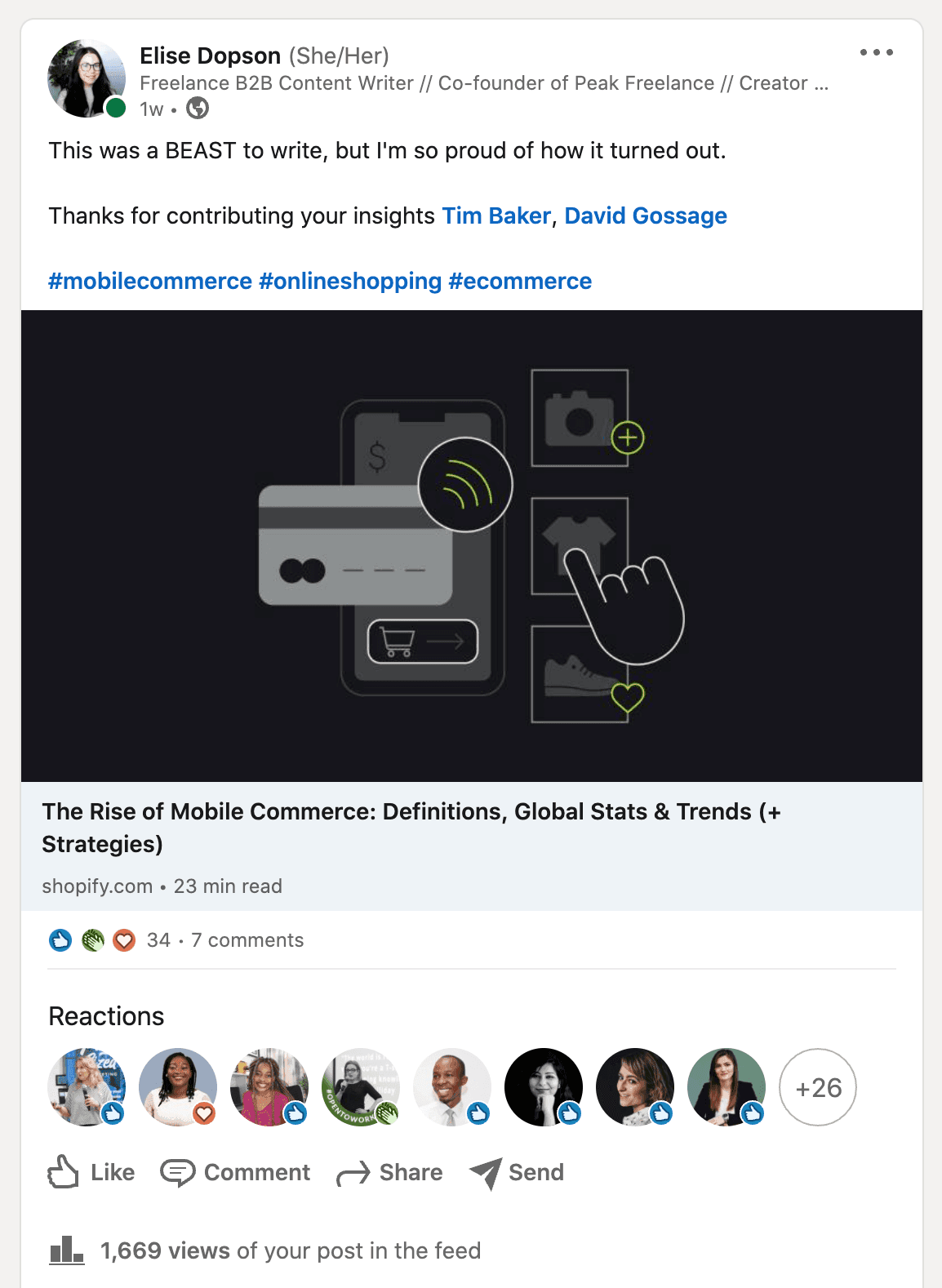
Social Signals Are Not Used by Google Yet… But it’s Coming
While social media signals aren’t used in Google’s algorithm, there’s definitely a correlation between how much virality a piece of content has and its organic search rankings.
However, there are still certain factors that make it difficult for search engines to rely on social media metrics when deciding where a page should rank. That includes:
- Volume: Over 293,000 Facebook posts are shared every minute. Instagram users upload 95 million videos and photos every day. Social media platforms have too much information to cope with search engines’ current infrastructure.
- Timing: Because so much social media content is posted every day, posts quickly become old news. Search engines prioritize fresh content—but there’s so much of it on social media that week-old content quickly becomes stale.
- Context: The social media world moves fast; the blogging world doesn’t. Search engines can struggle to map the relationship between social media profiles and evergreen content.
- Fake followers: The value that comes with a large social media following means brands are enticed into paying for fake followers. It’s not easy to identify them.
- Paid engagement: Companies can hire bots to spam content and inflate their engagement metrics. Search engines run the risk of prioritizing bad content with lots of fake social media engagement over valuable content with minimal (but real) engagement.
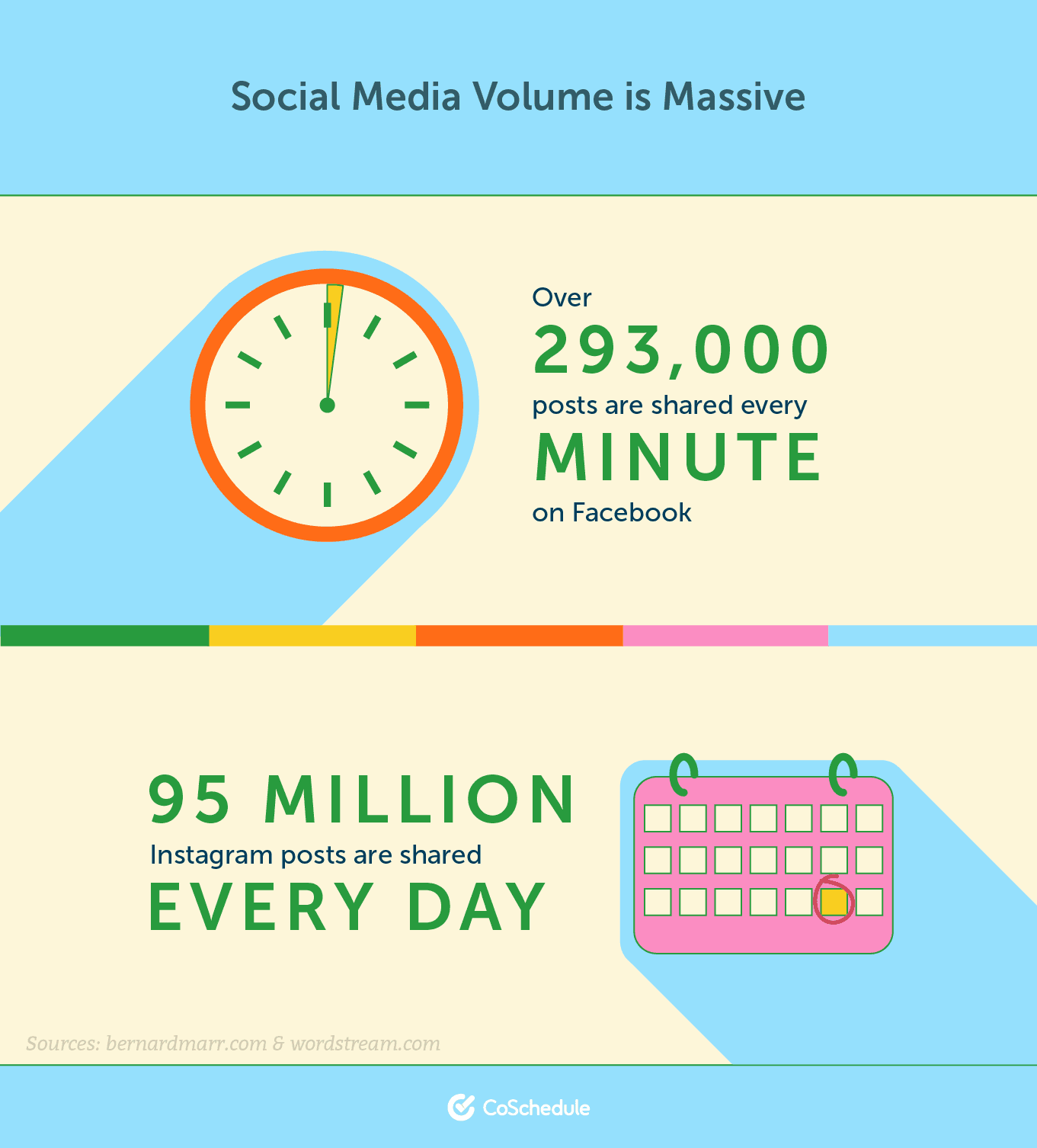
The bottom line? Social media raises brand awareness.
That leads to a bunch of SEO benefits—including an increase in branded search, and more trust from Google in that your content is the best solution to a searcher’s query.
Use these tips to get your SEO and social media departments on the same page. Remember, you’re both working together to reach the same goal: more customers.
The post How Social Media Can Help Boost Your Organic Rankings appeared first on CoSchedule Blog.



